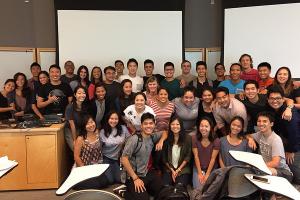Record number of medical students diving into 5-month-long training stints statewide
University of Hawaiʻi at MānoaDirector of Communications, Office of Dean of Medicine
Dr. Jill Omori, (808) 692-0932
Director, Office of Medical Education, Kakaako
People heading for medical appointment checkups in communities all over the state have a chance to get to know 39 University of Hawai'i students at the UH John A. Burns School of Medicine very well. And it works both ways. The future doctors will get to know the people in those communities better, too.
The 39 men and women represent a record-size group of future doctors who have signed up to spend a five-month stretch in a single place, learning from six faculty physicians called "preceptors." The course is the longitudinal clerkship program and it is an alternative track for third-year medical students at the medical school.
The students are paired with preceptors -- frequently MDs who volunteer their time -- at medical offices, clinics or hospitals on Oʻahu, Hawaiʻi Island, Maui and Kauaʻi.
Twenty-four of the 39 students are stationed on Oʻahu this year in communities including Waimanalo, Kailua, ʻAiea, Mililani, Waipio, Wahiawā, Haleʻiwa, Kalihi and downtown Honolulu. Fifteen students are residing and training on the neighbor islands during their five-month assignments.
"The longer-term training in those communities allows the medical students to get intensive one-on-one mentoring from the physician they are paired with," said Dr. Jill Omori, JABSOM's director of medical education. "The students also get to witness the continuity of care (the care of a patient over a period of time, often including ongoing health management), which is an important concept in health care today."
Dr. Nash Witten (JABSOM MD 2017) enjoyed his longitudinal training so much that he wrote about it during his stint on Hawaiʻi Island. "This rural clinical experience would not be possible without the tremendous support of community physicians, community donors and logistical support from the JABSOM Office of Medical Education," Witten wrote. "We need a car to get to clinics, so JABSOM ships our cars over. We need a place to stay, and neither would be possible without support from local donors who help to offset these costs."
Most importantly, the future doctors need physicians in all of the required fields to spend endless hours with the learners over those five months. Signing up to train medical students means numerous forms to fill out, tons of questions to field from enthusiastic, curious students, and the willingness to assert constant supervision as the students practice their novice clinical skills. Medical student learning in Hawaiʻi also isn’t possible without the hundreds of patients each year who agree to let a medical student observe their care.
Clinical training for all JABSOM medical students is a partnership with the community. While many medical schools have university hospitals, JABSOM faculty are based (and provide physician services) at a variety of community healthcare facilities. They include The Queen’s Health Systems, Hawaiʻi Pacific Health (Kapi‘olani Medical Center for Women and Children, Pali Momi Medical Center, Straub Medical Center), Kuakini Medical Center, Kaiser Permanente, the U.S. Department of Veteran’s Affairs/Tripler Army Medical Center, the Physician Center at Mililani, Rehabilitation Hospital of the Pacific, Shriners Hospital for Children, Wahiawā General Hospital, the Hawaiʻi State Department of Health and multiple other sites.
For more information, visit: http://jabsom.hawaii.edu/news-media/uh-med-now/

